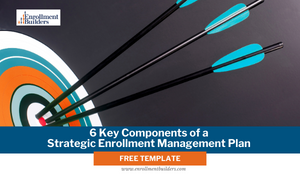Are you looking for enrollment management strategies for increasing student enrollment at your...
7 Key Components of a Strategic Enrollment Management Plan
 "He who fails to plan is planning to fail," Winston Churchill famously said. While he was speaking about war plans in World War II, his words of wisdom hold true for contemporary enrollment management.
"He who fails to plan is planning to fail," Winston Churchill famously said. While he was speaking about war plans in World War II, his words of wisdom hold true for contemporary enrollment management.
Having a strategic enrollment management plan for your institution means you’re more likely to succeed in establishing priorities, combatting uncertainty, and achieving your student enrollment goals. We know, though, it’s not always easy to create a strategic enrollment management plan from scratch.
In this article, you'll learn how to create a strategic enrollment management plan and you can download a free SEM plan template to customize for your institution.
Use the information in this article about strategic enrollment management and the free template to create and communicate guiding principles and priorities for the next two to five years.
What is Strategic Enrollment Management in Higher Education?
Strategic Enrollment Management, or SEM, is all about getting the right students to enroll in your institution and making sure they stay until graduation. It's a game plan that covers everything from marketing and admissions to student services and financial aid.
The goal of a Strategic Enrollment Management Plan for higher education is to boost enrollment numbers, improve student retention, and ultimately, increase graduation rates.
SEM helps institutions identify their strengths and weaknesses, target their marketing efforts, and offer financial aid more effectively. It's about ensuring your seats are filled with students who are a good fit for your institution and are likely to succeed. With a solid SEM plan, you can better allocate resources, enhance the student experience, and secure their long-term success.
How to Create a Strategic Enrollment Management Plan
The strategic enrollment management plan example we’re outlining for you here has seven components:
-
- The Introduction
- Institutional and Situational Assessment
- Student Recruitment and Enrollment Strategy
- Student Retention and Student Success Strategy
- Marketing Strategy (Optional)
- Student Financial Support Strategy (Optional)
- The Conclusion
1. The Introduction
-
- Summarize the focus of the plan
- Give some key institutional data
- List the plan’s contributors and the strategic enrollment management committee members
- Include the mission, vision, and guiding principles for the enrollment management department or division at the institution
The Introduction is the cornerstone of your Strategic Enrollment Management plan, setting the tone for what's to come. You'll provide key data that offers a snapshot of your institution's current state, serving as a baseline for measuring future success. The names of those who have contributed to the plan, as well as the members of the SEM committee, are listed to ensure transparency and accountability.
Most importantly, the Introduction will encapsulate the mission, vision, and guiding principles that will steer your enrollment management strategies. This comprehensive overview ensures that everyone involved has a clear understanding of the plan's objectives and the roadmap to achieve them. With a well-crafted introduction, you pave the way for the strategies and tactics that follow.
2. Institutional and Situational Assessment
This section outlines and explains the circumstances that have led to the strategies and tactics that will be presented in future sections. It is a picture of where the enrollment management department is currently.
Similar to a SWOT (strengths, weaknesses, opportunities, and threats) analysis, the institutional and situational assessment focuses on institutional strengths and challenges, as well as environmental opportunities and threats.
When conducting your institutional and situational assessment, be sure to discuss:
-
- Enrollment Processes - document your entire enrollment and admission process from the perspective of a student
- Enrollment Trends - record at least three to five years of enrollment history; include headcount and credit hours by degree level, learning modality (online, on-campus, blended), and student type
- Service Area Demographic Trends - define your service area, and then include demographic data on high school graduates and adult learners; note any other demographic realities and/or anomalies
- Occupational Trends - identify current and future job and career opportunities for your student populations; note any specific influences on students in your service area
- Resource Constraints - list any operational or logistical concerns that affect your enrollment efforts; may include residence hall capacity, financing and capital considerations, technology barriers, and human resource limitations
- Competition - identify local, regional, and national competitors for your specialized and differentiated programs
By thoroughly assessing these areas, you gain invaluable insights that inform your strategic enrollment management plan. It helps you identify gaps, allocate resources more efficiently, and set realistic, data-driven goals. This section is not just a checklist but a strategic exercise that sets the stage for the actionable steps that follow in your SEM plan. With a well-executed Institutional and Situational Assessment, you're better equipped to make informed decisions that align with your institution's mission and long-term objectives.
3. Student Recruitment and Enrollment Strategy
This section should identify the goals and objectives for student recruitment by degree program and learning modality. It should also identify the specific metrics and key performance indicators (KPI) that will be used to determine if the goals have been accomplished. It’s important that your plan eliminates uncertainty in the enrollment process.
Example
GOAL 1: Increase the number, diversity, and level of academic preparedness of new students
OBJECTIVE 1.1: Increase the number of first-time students from out-of-state markets
ACTION STRATEGIES:
- Consider providing coaching, resources, and training to improve the quality of the conversations your team is having with prospective students
- Determine the way you are reaching prospective students and consider the role that SMS and phone play in your outreach
- Analyze search yield rates and focus on purchasing prospect names from out-of-state vendors that convert at higher rates
- Increase the number of prospects we purchase that are interested in our high yield academic programs
- Consider increasing the discount rate for out-of-state students
- Utilize the University’s resources, faculty, coaches, and staff to contact applicants who need persuasion
KPI: A 5% increase in first-time freshmen from outside the State of Ohio
4. Student Retention and Student Success Strategy
Enrollment management is the sum of recruitment plus retention. In fact, a plan that neglects to include retention is missing out on the most important part of enrollment management: student success.
This section should include goals, strategies, and narratives about important factors like faculty engagement, financial aid, engagement with peers (extracurricular activities), and academic support programs.
Just like the recruitment section, this area should also include specific metrics and KPIs for each of the retention strategies identified.
5. Marketing Strategy (Optional)
Since many enrollment managers are also responsible for marketing, and because the institutional reputation (its brand) is so important to recruitment and enrollment, it is also good to include a section on the marketing strategy.
Here, the plan should include the tagline, brand promise, brand attributes, and a general description of the evidence to suggest why the branding strategy is relevant and applicable. More importantly, the strategies associated with market research, advertising, the institutional website, and direct marketing tactics should be identified and discussed.
Identify what’s working and what isn’t. If you’re having trouble figuring that out, spend time examining your marketing strategy to get those answers first.
6. Student Financial Support Strategy (Optional)
Another optional section is one devoted to financial aid strategy. Some institutions utilize tuition discounting heavily, especially those that serve traditional-aged undergraduates. Other schools are dependent upon state support and need to inform readers about those realities. The focus here is not just on the numbers but also on the strategic alignment of financial aid policies with your institution's overall goals and student demographics.
By including a well-thought-out Financial Aid Strategy in your SEM plan, you provide a transparent and thorough framework for one aspect of strategic enrollment management. It allows you to align your financial resources with your enrollment goals effectively, ensuring that you're not just filling seats but doing so in a way that is financially sustainable and aligned with your institution's mission.
7. The Conclusion
The conclusion should summarize the plan in a few paragraphs and tell readers and stakeholders when the plan will be revisited.
Before You Create a Strategic Enrollment Management Plan
We know you’re eager to get your plan formalized and in place. But before you get started, take note of these important reminders:
- To gain helpful insight into your admissions process, review your entire enrollment and admission process from the perspective of a student. This type of research gives you and your leadership team data that identify weak points in your admissions process.
- Your Strategic Enrollment Management Plan should complement your institution’s Strategic Plan. What enrollment-related goals and objectives in that plan will influence yours? Craft your enrollment management plan with those in mind.
- You should include administrators, faculty, and staff as you develop a Strategic Enrollment Management Plan.
- Expect the process to take three to six months. It will necessitate several meetings, committee assignments, and the allocation of resources in order to come up with a solid plan.
- You should review your plan annually, and generate a new plan every three or four years.
- Not sure how to begin? Download the free Strategic Enrollment Management Plan template to save time. Using the information here and the template, you can customize your plan for your institution.
Get More Help with Enrollment Management
We have a proven track record of helping educational institutions achieve their goals while maximizing every dollar, every hour, and every resource.
Our Higher Education Call Center Services are at the forefront of this success. Whether you need help developing a Strategic Enrollment Management Plan, want to explore solutions for generating and nurturing new qualified leads through our Higher Ed Call Center Services, or are looking for a more comprehensive, “wrap-around” partnership to help you reach long-term enrollment goals, we can help. Our Enrollment Call Center Services and enrollment management services are designed to give flexibility and responsiveness to keep your institution on top of its students' needs.
If you’re ready to hear more, we invite you to meet our team for a quick, no-pressure intro call. Schedule some time now to discover if Enrollment Builders is a good fit for you.

%20(500%20%C3%97%20100%20px).png?width=500&name=DOWNLOAD%20SEM%20PLAN%20TEMPLATE%20(500%20%C3%97%20200%20px)%20(500%20%C3%97%20100%20px).png)

